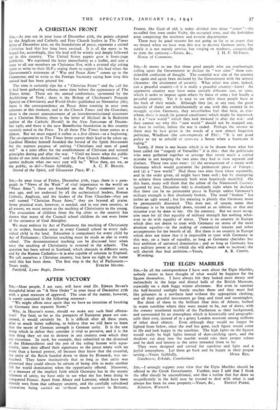THE ELGIN MARBLES
Snt,—In all the correspondence I have seen about the Elgin Marbles, nobody seems to have thought of what would be happiest for the figures themselves. I have always felt they looked most dreary and melancholy in the large and dismal halls of the British Museum, especially on a dark foggy winter afternoon. But even in summer the half-hearted sunlight barely reaches them and they must feel like prisoners in a northern land without the appropriate clothing, and all their graceful movements go limp and tired and meaningless.
But think of them in the brilliant blue skies of Athens, bathed in warm sunshine where they were meant to be, out of doors, with the creamy weathered marble of the Parthenon as their background, and surrounded by an atmosphere which is historically and geographi- cally their own, instead of in a grimy London museum among millions of other dead objects. Even although they would no longer be lighted from below, since the roof has gone, each figure would come to life and look happy in the sunshine. The high lights on the figures would really be high lights instead of dust-catching spots, and the shadows cut deep into the marble would take their proper values and be dark and intense as the artist intended them to be.
They were designed and carved for sunshine and light and a joyful atmosphere. Let them go back and be happy in their proper


























 Previous page
Previous page